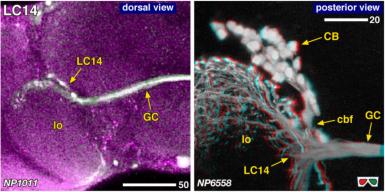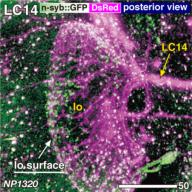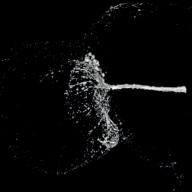| Accession number: | 10013 | |
| VFB id: | FBbt_00100486   | |
| Neuron name: | LC14 |
| Synonyms: | Cco, GC, atoGAL4 |
| Position of cell bodies: | LCBR-LD |
| Number of cells: | 32-38 |
| Neuron class: | visual projection neuron, lobula columnar neuron |
| Innervating regions: | Lo_surface |
| Presynaptic sites: | Lo_surface |
| Postsynaptic sites: | |
| Direction of information: | contra |
| Laterality: | inter-OL |
| Publications: | -
Otsuna and Ito (2006) J. Comp. Neurol. 497:928-958 |
| |
| Strains / Antibodies: | NP1011-Gal4, NP1320-Gal4, NP2620-Gal4 |
| |
| Morphological description: | The great commissure (GC) is a thick bundle of neural fibers that connect lobulae on both sides of the brain. It was initially described by Power (1943, 1946) as Cco (central commissure). The LC14 neurons project along this tract (Fig. 1). They were also visualized by Fischbach (1983) using Golgi impregnation and by Morales et al. (2002) as atonal-GAL4 expressing cells using the atoGAL4-14A strain. We identified 32–38 cell bodies in the mid-dorsal area of the lateral cell body region. Like other LC neurons, the cell body fibers run toward the neck of the lobula (Fig. 1, the left panel). Unlike other LCs, however, the projections of the LC14 neurons are limited only near the surface of the lobula (Fig. 2). Although the fibers appear columnar, they do not enter the lobula neuropil at any layer. Thus, the LC14 neurons cover only the peripheral area of the visual field.
LC14 neurons are also unique in that they probably have no synapses within the central brain. The n-syb::GFP signal is observed in the lobula but not in the great commissure (Fig. 3). Interestingly, a subset of arborizations in the lobula is devoid of presynapses. Considering that unidirectional centripetal neurons such as LC4 and LC11–13 have no presynapses in the lobula, it is probable that each LC14 neuron is also unidirectional, sending information from one lobula to the other. The branches that are not labeled with n-syb::GFP are therefore likely to be the dendritic arborizations.
Among the four GAL4 strains we identified, NP6558 has its GAL4 insertion site in the locus of the atonal gene, and it is likely that the strain reflects its expression pattern (Morales et al., 2002). In addition to the LC14, NP6558 labels intrinsic neurons in the lobula plate as well as a variant of the LC14 neurons that send thin projections to the medulla, which may connect the medulla in each side of the brain.
|
| |
| Functional description: | |
| |
| |
| Figure 1: |  |
| 3D stereograms from three viewing angles. (Neurons other than LC14 are erased from the data.)
CB, position of the cell bodies; GC, great commisure; cbf, cell body fiber. Modified from Otsuna and Ito (2006). |
| |
Figure 2: |  |
| Detailed arborization patterns of LC14. Sections of LC14 at level of the GC, showing the arborization confined in the peripheral part of the lobula.
Modified from Otsuna and Ito (2006). |
| |
Figure 3: |  |
| Distribution of the presynaptic sites. Staining with the presynaptic site-targeted n-syb::GFP (green to white) and cytoplasmic DsRed (magenta). White characters with under bar indicate the areas of arborizations with presynaptic sites. Modified from Otsuna and Ito (2006). |
| |
File 1: |  |
| QTVR movie of LC14, from Otsuna and Ito (2006). |

